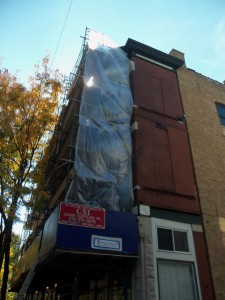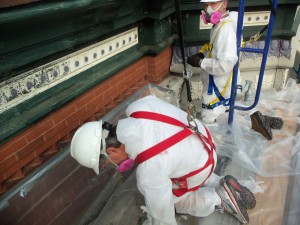A paint restoration project can involve much advanced planning and equipment, especially for an old building in a large urban area like Chicago. Before any work can be performed, power lines will have to be moved because of their proximity to the work areas. The Chicago Department of Operations handles that service, at a hefty cost! Additionally, there may be an additional low voltage wire for police and fire communications that will need to be wrapped. That service is performed by a different Chicago Department, this one at no cost, amazingly.
An old city building is often right up against the sidewalk and, if it has bay windows on its façade, the building actually extends three or four feet over the sidewalk. Consequently, city ordinances require the erection of a canopy over the sidewalk to protect pedestrians. It also must remain lit from dusk to dawn. Once that work is completed, the scaffolding can then be erected to ensure safe and comfortable access to all work areas. In the case of our paint restoration project in the Old Town neighborhood of Chicago, four layers of scaffolding covering the entire façade needed to be installed. The scaffolding company secured the necessary permits prior to installation. Lastly, our painting project will require the rental of a scissor lift to reach a section of the cornice that extends into the alley. A separate permit has to be secured for the use of space in the alley.
Once the work above has been completed, two important aspects need to be addressed before work can begin on the painted surfaces. First, dust containment must be set up, as required by the RRP rules. In our case, it involved the set up of 4 mil plastic barriers on both ends of the scaffolding, the use of 6 mil plastic to seal the canopy to the edges of the building and the containment of the work areas to capture the paint debris and dust. The second aspect involves personal safety equipment to meet OSHA and EPA requirements. In our paint restoration project, it involved the use of fall arrest protection equipment, hard hats, dust suits, special respirators and eye protection. Having now completed all the surface preparation, we are ready to paint, finally!









 Follow
Follow
